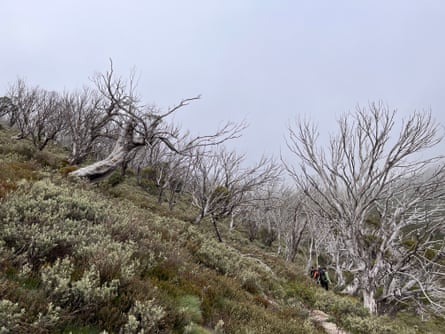As global heating cuts Australia’s snowfall ski season may go downhill, report warns
Bookings have been slow ahead of the ski season at the mountain lodge in Thredbo that Annalisa Koeman’s parents built in the 1960s and have run ever since.
Last ski season started with some good snow falls “but it went downhill from there. It was a disastrous end. The ski lifts closed two weeks early,” says Koeman, managing supervisor at Kasees Apartments and Mountain Lodge.
Customers are probably waiting for decent falls after being disappointed last year, she says.
“The webcams do not lie,” she adds, pointing to live images on Tuesday of isolated patches of snow on ski runs.
-
Sign up for Guardian Australia’s free morning and afternoon email newsletters for your daily news roundup
According to a major new report from the Australian National University, the average length of ski seasons will be cut from the current 105 days to 81 by 2030 and just 70 days by 2050 even if greenhouse gas emissions are cut radically.
Under middle-of-the-road emissions, the season could be just 61 days by mid-century – a 40% cut on conditions today. If emissions remain high then by 2080 there would be enough snow to ski for only a handful of days.
“We can feel it and see it; we know it’s happening,” Koeman says.
The impacts are not uniform. Resorts such as Thredbo, Perisher and Charlotte Pass in New South Wales, and Victoria’s Mt Hotham and Falls Creek, are not as badly hit in the future as others, the modelling says.
The ski resorts of Mt Buller, Mt Baw Baw, Mt Stirling, Lake Mountain, Mt Selwyn and Ben Lomond are most vulnerable, the report says.
“If these resorts continue to rely predominantly on winter skiing, they are unlikely to be economically viable past the next few decades.”
Commissioned by volunteer-run climate advocacy group Protect our Winters Australia, the wide-ranging report examines what global heating could mean for industries like tourism and hydropower; for the Murray-Darling Basin (almost a third of the basin’s annual flows are from the high country), for First Nations people and for unique ecosystems.
“Australians love skiing in the alps not because it’s the best skiing, but because it’s close and it’s culturally significant and it’s just a beautiful place to be,” says ANU plant ecologist Prof Adrienne Nicotra, director of the Australian Mountain Research Facility and one of the report’s authors.
The modelling includes allowances for snow making and is designed especially for ski fields.
Nicotra said the model is forecasting a drop in snowfall and a rise in temperatures. Snow cover in the alpine region had already dropped by about 30% between the 1950s and 2012.
But the report also outlines widespread impacts on ecosystems, including on snow gums – the only tree that can survive in the sub-alpine landscapes.
Threatened by increasing frequency of bushfires, the trees are also suffering a die-back likely linked to water stress and the changing climate that’s favouring a native wood-boring beetle.

Even if skiers don’t notice a decline in snowfall, they might see the suffering snow gums, Nicotra says.
“It’s becoming apparent that a lot of the trees around the resorts are dying.”
The report includes recommendations for communities and industries to be more resilient and to find ways to diversify as revenues from downhill skiing drop away.
“The modelling shows pretty clearly we need rapid and continued cuts to climate pollution this decade to give these regions and these industries the best chance of thriving passed 2050,” says Sam Beaver, a researcher at the ANU Institute for Climate, Energy & Disaster Solutions and a volunteer policy adviser at Protect our Winters.
A spokesperson for the Mt Buller resort, due to open this weekend, said there were hopes of good snowfalls about 11 June.
“We’d remind people who are worried about a snow holiday that on Mt Buller we are skiing more days on average than we were 40 years ago thanks to careful management of the ski area and using technology to make and manage reliable snow cover.”
A statement from the Australian Ski Areas Association, representing ski field operators, said resorts are “leaders in embracing new technology and year-round investment to adapt and mitigate against the season to season variability of weather and snowfall.”
Back in Thredbo, Koeman is worried about the future.
“It’s concerning when you see a lack of international and national action [on climate change] and you know it’s trickling down to you.
“This is an extremely fragile, unique place at the top of Australia. For species here, there’s no further up that they can go.”
Source: theguardian.com

